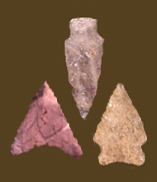
Projectile Points Search By Type Name
|
|
POTOMAC
Chronology For information about similar Archaic Period triangular points, click here. Haft Element: The base is straight or concave. At the type site for the point, Accokeek Creek, 50% of the bases are concave, often extremely concave, while the other half are straight (Stephenson and Ferguson 1963). Size: Equilateral specimens range from 16 to 26 mm in length and width, with an average of 21 mm. They are 3 to 7 mm thick, with a mean of 4 mm. Technique of manufacture: Well-made and symmetrical, with fine pressure flakes on both sides. Material: At the Accokeek Creek site, 91% of 536 points were quartz, with the rest being quartzite, chert, slate, or argillite (Stephenson and Ferguson 1963). In a sample of 53 Potomac points from the lower Patuxent drainage, Steponaitis (1980) reported that 98% were quartz, with the rest chert (2%). In the area surrounding Zekiah Swamp on the lower Potomac, Wanser (1982) found that 91% of 59 Madison points were quartz, with lesser amounts of chert, quartzite, and other materials. Quartz is the dominant material for Potomac points in the middle Potomac River Valley, but quartzite, chert, and rhyolite are also used (Hranicky 2002). In the Hagerstown Valley, over half of the triangular points were rhyolite, followed by lesser amounts of chert, jasper, quartz, and quartzite (Stewart 1980). In Delaware, triangular points are most commonly made from quartz, jasper, and chert (Custer 1996a). Discussion As a general rule of thumb in Maryland, small Late Woodland period equilateral points can be classified as Potomac, large equilaterals as Levanna, and isosceles points as Madison. However, the published type descriptions for all three show considerable morphological overlap. As a result of this, and given also the potential modification of triangular points through resharpening, the assignment of type names and dates to individual specimens can be problematic. Some researchers prefer to combine all the Late Woodland triangular points into one type (cf. Custer 1996a; Wall et al. 1996). Defined in Literature References Coe 1964; Custer 1996a; Hranicky 2002; Potter 1993; Stephenson and Ferguson 1963; Steponaitis 1980; Stewart 1980; Wall et al. 1996; Wanser 1982 |

|
Thank you for visiting our website. If you have any
questions, comments, Copyright © 2002 by |

|

 Defining Attributes
Defining Attributes